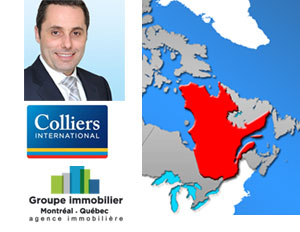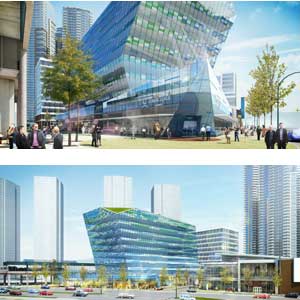By Paul Brent on Jan 14, 2016 11:41 am
Colliers International Group Inc. kicked off the new year with the purchase of independent commercial real estate services and landlord representation firm Le Groupe Immobilier de Montréal (GIDM), adding a new capability and service offering in Quebec.  Colliers believes it can quickly grow the client base of the Montreal-based company by plugging it into its national services platform. Also, a shift in the Quebec real estate market bodes well for third-party services providers. Colliers believes it can quickly grow the client base of the Montreal-based company by plugging it into its national services platform. Also, a shift in the Quebec real estate market bodes well for third-party services providers.
“We really believe the landlord services will be a growth engine going forward, said Andrew Maravita, managing director for Colliers International in Quebec (shown in image). “There will be more and more demand in the greater Montreal area from the institutional landlords and that is why we made the acquisition.” Terms were not disclosed. In business for 30-plus yearsGroupe Immobilier, which has been in business for more than three decades, currently has more than seven million square feet of space under management, clustered in the Montreal and Quebec City markets. Maravita said it made sense to buy out the seven-person Montreal firm “and leading market share presence” rather than build a practice from scratch. “Our goal is to double that in the next three years,” he said. “Double the size of the group and double the size of the square footage under management.
“With the combination of (GIDM’s) expertise combined with Colliers’ platform and reputation globally, I think that we can get more institutional clients and more private clients on board.” Evolving marketColliers’ Quebec managing director noted there is plenty of new construction coming on stream in the province’s office market, putting pressure on existing buildings. “It is becoming a challenging market for landlords. It is really a strong tenants’ market so I think it really requires a very aggressive approach on leasing and building identity for the various buildings in the portfolio when you are challenged with brand new product and a market with a growing vacancy rate.” He estimates the current vacancy rate in Montreal’s downtown core to be approximately 13 per cent, an estimate that does not include sub-lease space of about 800,000 square feet, “If you were to add it in, you would be in the 20s easily.” Downsizing, tooOn top of new construction, some tenants are also downsizing their space requirements by utilization of more efficient open-concept configurations. “That is causing a real increase in sub-lease space which is already built out at a much lower cost,” he said. “It makes for a very, very competitive marketplace.” It creates a scenario that is tough on internal leasing teams, he said. “They are good with their tenants and they are good with renewals, but when you are getting into a very competitive market, I think it requires a different expertise which is a more dynamic, aggressive approach.” A different mindsetNational firms such Colliers have built their businesses on convincing landlords on the benefits of outsourcing real estate services. In Quebec, that process is not as far along. “Here, landlords have taken a more traditional approach compared to definitely the Toronto market or out West where there is natural outsourcing. Here in Quebec, it is starting but it is still relatively new.” Colliers is counting on GIDM’s hard-won expertise and the big firm’s systems and platform to “make for a convincing argument where they would feel comfortable now outsourcing.” He estimates about 30 per cent of Quebec landlords currently outsource landlord services, a percentage that will rise over time. “We are seeing some trends where the large landlords are realizing that leasing is not exactly their core business and they should be focusing on asset management and returns and acquisitions and dispositions.” The post Colliers looking to double Quebec CRE services appeared first on Canadian commercial and residential real estate news at RENX.
Read in browser »
 
By Steve McLean on Jan 14, 2016 03:07 am
Continued low interest rates are expected to contribute to Canadian commercial real estate (CRE) remaining an attractive investment in 2016 despite ongoing challenges imposed by the broader economy.  “Clearly there are pockets of concern throughout the country, but overall conditions remain pretty good,” said Paul Morassutti, CBRE Canada’s executive vice-president of valuation and advisory services, who contributed to the real estate company’s Canadian Cap Rates & Investment Insights Q4 2015 report. “Clearly there are pockets of concern throughout the country, but overall conditions remain pretty good,” said Paul Morassutti, CBRE Canada’s executive vice-president of valuation and advisory services, who contributed to the real estate company’s Canadian Cap Rates & Investment Insights Q4 2015 report.
“I think the market has really been quite resilient.”
Cap rates remain relatively stable across most cities and asset classes, and top-performing properties should see their rates contract this year. The spread between the six per cent national average cap rate and the 1.39 per cent rate for 10-year Government of Canada bonds rose by six basis points to 461 basis points in the fourth quarter. “Capital is seeking safety and security, and hard assets provide that,” said Morassutti. “You could argue that in times like this, when the rest of the world seems to be blowing up and stock markets are short-circuiting, real buildings with real tenants and long-term leases have even greater appeal to buyers.” Vancouver a resilient marketThe Vancouver market continues to gain momentum and strong demand will maintain investment volumes and support record low cap rates. New office space came on the market and the city’s vacancy rate rose slightly, though that hasn’t scared off foreign or domestic investors. “For the past 25 years, it has been one of the safest and least volatile and most resilient real estate markets in the world,” said Morassutti. “I’d put it up there with London and Manhattan in terms of stability to preserve capital and demand for product.” Morassutti believes Toronto commercial real estate will also remain attractive to investors by virtue of the size of the market, although there are large fluctuations in its performance depending on area.
He cites average office vacancy rates of about five per cent for class-A office buildings downtown and one per cent in the south core, the area with most of the new office construction. At the same time, some pockets in the suburbs are experiencing vacancy rates of close to 30 per cent. Hotels in Toronto and Vancouver remain strong, with lower cap rates for downtown full-service hotels. Alberta hit hard by low oil pricesToronto and Vancouver also benefited from capital fleeing Alberta due to continuing low oil prices, and the Wild Rose province is poised for more problems this year — particularly the downtown office sectors in Calgary and, to a lesser extent, Edmonton. “That’s due to the unfortunate timing of new supply coming on stream at the exact time that demand is clearly declining,” said Morassutti. “The result is what we see today, which is vacancies going up almost every month.” While this should hypothetically cause cap rates to rise, there’s been little movement due to a large bid-ask spread as owners of top properties are taking long-term views instead of dumping them at fire sale rates. “The Brookfields, the Bentalls, the Oxfords and the Cadillac Fairviews of the world have no intentions of selling any of their product in this type of market,” said Morassutti. “We’re very well-positioned in Canada with extremely strong ownership. We haven’t added too much new supply and we’re not overleveraged as an industry.” Morassutti points out quality retail, industrial and multi-residential properties in Alberta have held up better than most people realize. For the most part, that also applies across the rest of the country. “If I had to pick sectors that are going to struggle a bit, I’d say power centres in secondary markets or power centres that still have Target vacancies,” said Morassutti. Other Canadian marketsMeanwhile, slower trading and minimal cap rate movement characterized the fourth quarter in Montreal, while the scarcity of high-quality product maintained tight yields for all property types in core areas. Mid-sized development sites continue to receive strong interest from a broad range of investors. The change of federal governments has injected a renewed sense of optimism in the Ottawa commercial real estate market, which is expected to enhance liquidity. Pent-up demand for core downtown office buildings should continue. Institutional buyers are actively pursuing opportunities in Waterloo Region, including the 26-acre former Maple Leaf Foods infill site in downtown Kitchener. There’s been a flurry of development and land purchases along the 19-kilometre light rail transit line being built from Waterloo’s Conestoga Mall to Kitchener’s CF Fairview Mall. The region continues to offer enhanced returns compared to other Canadian markets, with the cap rate differential for quality properties hitting 100 basis points in some cases. A number of new office projects were completed in Halifax in late 2015, and more are expected this year, which will put upward pressure on vacancy rates. Urban residential development sites were in demand last year, with record pricing for well-located sites. The post CRE should overcome economic challenges: CBRE appeared first on Canadian commercial and residential real estate news at RENX.
Read in browser »
 
By Steve McLean on Jan 13, 2016 11:40 pm
The recent opening of Coast Capital Savings’ “Help Headquarters” completes the first phase of The HUB at King George Station development and marks the next step in the impressive evolution of Surrey, B.C.  “Surrey is a really exciting place with a growing, young and educated population, with the Surrey city centre — where we are — anchoring it at this transit hub,” said Tim Grant, vice-president of investment for PCI Developments Corp., the company that built the 185,000-square-foot facility for approximately $100 million over two years. “Surrey is a really exciting place with a growing, young and educated population, with the Surrey city centre — where we are — anchoring it at this transit hub,” said Tim Grant, vice-president of investment for PCI Developments Corp., the company that built the 185,000-square-foot facility for approximately $100 million over two years.
“Given all the government infrastructure that’s been put in over the last several years, we’re starting to see things take off and there’s really good demand to be in the area. From our standpoint, it’s a community to watch.” Surrey growing in size and influenceSurrey is British Columbia’s fastest growing and second-largest city. It was named the best place for small business in Metro Vancouver and is the only Canadian city to be named to the 2015 “Top 7 Intelligent Communities” list by the international Intelligent Community Forum. Coast Capital, in partnership with the applied research and consulting division of furniture supplier Steelcase, conducted numerous workplace studies when considering the interior of the office space, which also has a unique exterior designed by architectural firm Musson Cattell Mackey Partnership. Coast Capital, Canada’s largest credit union by membership, occupies floors five through 10 of the 10-storey building. Each of its open-concept floors incorporates formal and informal community spaces, including several individual and smaller meeting rooms. There are themed cafes on every floor and recreational and reflective spaces to support a corporate culture of wellness, creativity and collaboration for the 700 Coast Capital employees. It includes retail and commercial businesses, a daycare centre operated by Kids and Company, and a gym with a yoga studio and lunchtime fitness classes. The LEED Gold-certified building has a living seed wall on the patio of its 10th-floor lookout. It features ample bicycle storage space, designated car pool parking spots and plug-in areas for electric vehicles.
Transit-oriented developmentSeventy per cent of Coast Capital’s staff live south of the Fraser River, so locating its head office at the crossroads of Surrey’s new downtown centre at the King George SkyTrain station on the Expo Line was a deliberate choice. The location is also close to the Fraser Highway, offering more commuting options for current employees and providing a desirable feature for attracting future workers. Two other proposed transit lines will have stations in the vicinity, connecting to Newton to the south and Langley’s city centre to the east. “In our market, to have three transit lines intersecting is really unique,” said Grant. “Outside of downtown Vancouver, I don’t believe there are any other places like that.” Grant compares the second phase of The HUB at King George Station to a PCI project in south Vancouver called Marine Gateway at Cambie Street and SW Marine Drive that sits on the Canada Line. Three future phasesThe HUB will feature more than 200,000 square feet of retail space and another 170,000 of office space as well as up to 500 condominium and rental residential units in a space featuring a large podium with two or three towers. “We’d like to get started with the retail and then carry on from there in terms of the office and residential,” said Grant. The third phase of The HUB at King George Station will be another office building with retail elements similar in size to Coast Capital’s new headquarters. Anchor tenants are being sought and construction will begin subject to demand, according to Grant. The fourth and final phase of The HUB at King George Station will be largely residential with some retail, with up to 800 rental and/or condo housing units. “That’s probably a couple of years away yet,” said Grant. All of the buildings will be built to LEED Gold specifications. (The image above is a rendering of the Capital Coast Savings headquarters from the PCI Developments website.) The post Coast Capital Savings anchors Surrey transit hub appeared first on Canadian commercial and residential real estate news at RENX.
Read in browser »
 
By Jeff Barton, Punta Pacifica Realty on Jan 13, 2016 07:32 pm
In many ways, 2015 was a key year for Panama City’s real estate market. There was a return to normalcy, as more and more buyers from around the world decided the local market represented a solid investment. The result was a steady increase in sales activity and pricing, driven by investors, second...
Read in browser »
 
By Steve McLean on Jan 12, 2016 08:53 pm
Quebec City’s Galeries de la Capitale shopping and entertainment centre is enhancing its $50-million redevelopment project with an additional $40 million in upgrades to its common areas.  “We want to provide an experience to the consumers visiting our mall,” said general manager Serge Rossignol. “Starting at the site entrances, moving toward the building and inside of it, we are working to achieve this experience for our customers.” “We want to provide an experience to the consumers visiting our mall,” said general manager Serge Rossignol. “Starting at the site entrances, moving toward the building and inside of it, we are working to achieve this experience for our customers.”
Galeries de la Capitale, which opened in 1981 and is owned by Oxford Properties and Canada Pension Plan Investment Board, began a $50-million redevelopment last spring to create a more engaging and eco-friendly dining experience at Espace Gourmet. This first phase will be completed in August. “The main improvements were to relocate the old food court on the second level near the Méga Parc,” said Rossignol. “We have also introduced full-service covers for our clientele to have the experience of dining in the shopping mall.” Environmentally friendlyIncreased composting and recycling as part of these changes will make the centre greener. Galeries de la Capitale will also add clothing and accessories retailer Old Navy and a BCBGMAXAZRIA women’s fashion store, while welcoming back a Dollarama bargain outlet, this spring. “We are constantly working to bring tenants that will respond to the demand of our consumers,” said Rossignol.
The owners are investing an additional $40 million to enhance the customer experience through renovating all mall entrances and corridors, including floors, ceilings, lighting, handrails and ways to help patrons navigate the complex. The work will begin in February and is scheduled for completion in November 2017. The two-storey Galeries de la Capitale has a surface area of almost two million square feet and features 280 shops and restaurants, with anchor tenants including Best Buy, Toys “R” Us, The Bay, Sears, Simons and a freestanding RONA. It provides such services as a personal stylist, coatcheck, information and customer service kiosks, purchase storage, a baby’s area, and stroller, walker and wheelchair rentals. Indoor amusement parkGaleries de la Capitale has also been home since 1988 to Méga Parc, the second-largest indoor amusement park in North America. It offers 17 family-friendly attractions, including a variety of rides, a skating rink, bowling alleys and a climbing wall. The complex also features an IMAX movie theatre with Canada’s largest screen. “We are leaders in what we do,” said Rossignol. “Our customers have asked for a revamped mall, new retailers as well as upgraded ones, which we are aligning ourselves toward. “We are proud of what we do and are pleased to be unique and able to provide under the same roof shopping, dining and entertainment.” (Image above compiled from pictures on the Reliance Construction website) The post An interior makeover for Galeries de la Capitale appeared first on Canadian commercial and residential real estate news at RENX.
Read in browser »
 
By Barry Stuart on Jan 11, 2016 07:53 am
 In a couple of my earlier blog posts: “Five key benefits of commercial real estate investing” and “Mainstream media’s obsession with the equities market” I discussed why commercial real estate is a viable investment vehicle. In a couple of my earlier blog posts: “Five key benefits of commercial real estate investing” and “Mainstream media’s obsession with the equities market” I discussed why commercial real estate is a viable investment vehicle.
It is surprising to some that in spite of the current tepid economy, our demand exceeds available product and is causing compression of some cap rates. There are a few reasons for this. Let me explain. Need to qualify demandIt is important to emphasize strong demand exists for investment real estate. When I am asked how our market is, I always need to provide an answer that does not generalize. We still have vacancy in the office and industrial sectors that has been sitting for a while. It is expected it could take some time yet to absorb that oversupply. It does not mean our entire investment market is strongAlthough demand is strong, investors are cautious. If it is an office or industrial property with significant vacancy, it will likely be looked over. If, however, the tenant base is relatively strong with reasonable remaining lease terms in a good location with a clean environmental history, we can sell it. Interest rates are a major factorObviously, low capitalization rates are likely to exist only within a low interest rate environment. I made a decision many years ago to not attempt to predict at any given time which direction interest rates are headed. There does seem to be a consensus among economists that rates are unlikely to rise significantly in the near term. That tells us Saskatchewan commercial real estate investment demand could stay strong. What are the alternatives?I ask you that question. Where do you have confidence that you can place your hard-earned money and see a reasonable return? We see much volatility in equities and dismal returns from GI’s and bonds. When it comes to investing there is no such thing as a sure thing, but diversity is the key to balanced risk. A great time to sellSo what’s my point here? If you have been considering selling your piece of “A” or “B” commercial real estate, why not let us provide you with an estimated market value? You might be surprised how much equity you have accumulated. We always advise you assess your situation fully before deciding to sell. Some questions to ask yourself: what are the after-tax net proceeds; is there a mortgage payout penalty; given my age and tolerance for risk, where is the best place to direct my sale proceeds? The post Strong demand for investment CRE appeared first on Canadian commercial and residential real estate news at RENX.
Read in browser »
 
By David Allison on Jan 10, 2016 07:22 pm
 What do 1,000 Baby Boomers, more than a dozen industry leaders, architectural giants Perkins +Will, and yours truly have in common? What do 1,000 Baby Boomers, more than a dozen industry leaders, architectural giants Perkins +Will, and yours truly have in common?
We’ve all been thinking and talking about Baby Boomers moving to Multi-Family Homes (MFH), and the collective output of all those brains will be presented at the UDI Pacific breakfast in Vancouver on Feb. 3. Here’s the story.The Stackable Boomer, my most recent book, looks at the largest migration facing our industry in the coming years: millions of Baby Boomers will be selling the house in the suburbs and looking for a higher-density lifestyle in MFH buildings across the country. But there’s a gaping hole in the market.There will be a huge demand for MFH from middle-class Boomers: the ones who aren’t all that happy about having to sell the house in the suburbs in the first place. But we aren’t building very much for them right now. You see, as an industry we’re already successfully building and selling homes to the wealthy Boomers who want a concierge and a wine-cellar and a built-in espresso machine in every room. But what about the Boomers who can’t afford all that? They don’t want to live in buildings designed for first-time homebuyers: they are scared of trying to sleep just down the hall from a part-time DJ who likes to have keg parties on the weekend. I’m generalizing, of course, but there is a lack of choice in the market for the Boomers who can’t afford the high-end product, and aren’t enthused about the entry-level product either. So we set out to find what they wantThe Stackable Boomer presents the results from a 1,000-Boomer survey that asked questions about the issues middle-class Boomers are grappling with. They responded with information about their biggest fears and dreams, their favourite rooms, what they are shopping for, and how we can make them happy. We also polled more than a dozen industry experts: from CEOs of major development companies and internationally recognized urban planners, to famous authors and Harvard professors. We asked them all what they thought about building better homes and communities for Boomers, and they shared some very insightful advice. And since talking to both the Boomers and the experts yielded more questions than answers, I recently went to my very smart architect friends at Perkins +Will, and asked them for some big ideas that could help. They came up with some amazing stuff. And what’s the answer?The answer is . . . you’ll have to come to the UDI Pacific Region breakfast to find out. I’ll be speaking about this subject for an hour or so, and I promise it will be an hour jam-packed with information that you can take back to your companies, and use to make your own careers even more stellar in the Boomer-centric market for MFH. Want to join me and enjoy Boomer Brains for Breakfast?Full information and tickets here. Want to win a pair of free tickets?Post this link on Twitter and LinkedIn, and use the hashtag #BoomerBrainsforBreakfast Everyone who does will be entered to win: I’ll be watching closely, and thank you in advance for your help! If you want to find me on Twitter I’m @IncDavidAllisonAnd on LinkedIn I’m hereThe post Boomer brains for breakfast! appeared first on Canadian commercial and residential real estate news at RENX.
Read in browser »
 
By Paul Brent on Jan 07, 2016 10:22 am
Crowdfunding startup NexusCrowd Inc. is celebrating its second successful money raise, gathering $500,000 over five weeks for a GTA industrial redevelopment.  The raise was part of a $5.8-million equity raise for Toronto-based Downing Street Realty Partners, which has two industrial properties in Toronto and one in Mississauga that require redevelopment and remediation spending. The raise was part of a $5.8-million equity raise for Toronto-based Downing Street Realty Partners, which has two industrial properties in Toronto and one in Mississauga that require redevelopment and remediation spending.
The Downing Street industrial properties, which total 110,000 square feet, have already undergone some redevelopment work. The two Toronto properties contain environmental contamination and are currently being remediated with an expected October completion date. New vehicleThe $500,000 raise, completed in December, marks the second successful crowdfunding venture for NexusCrowd and the first experience Downing Street has had with the funding vehicle. Marc Canale, a partner at Downing Street, said his company had watched the development of crowdfunding for commercial real estate in the U.S. and was eager for an opportunity to participate in this emerging financing market. “It is new to Canada, there are 175 firms in the U.S., but I think that there are a few of them popping up in Canada and I think there will be many more.” Canale, one of four partners at the venerable real estate firm, said the attraction of crowdfunding is what it can represent in the future rather than the $500,000 for its current project. “What we hope is that five years from now (NexusCrowd) is raising $10 million, $2 million in this deal, $5 million in this deal. Our intention is to grow with them.”
The Downing Street partner noted he worked for a number of years in Asia, where crowdfunding has been long established in a more rudimentary fashion. “(NexusCrowd) will be a much larger funding source for us down the road and the only way for them to start is to start small.” Canale added his firm expects to close on “a couple properties in downtown Toronto and southwestern Ontario in March and its new crowdfunding partner “will definitely be into the next deals.” Storied historyDowning Street, founded in 1986 by president/CFO Daniel Odorico, is well-established as both a lender in the real estate space and as a short-term owner of select properties close to its home base. For the most part, it is funded by high-net-worth investors contributing an average of $150,000 in both equity and debt investments. “We are value-add guys and then we exit. All the real estate we own is in Ontario.” Shoe leather may be the company’s most valuable asset. “We are like feet on the street guys,” says Canale. “We find opportunities off-market, banging on doors, making offers off-market. It is hard if you are not on the street.” Downing Street’s operating program calls for it to buy, redevelop and sell properties as quickly as possible. “Never more than two or three years,” explained Canale. That means the clock is ticking on the three industrial properties involved in the latest crowdfunding. “This particular transaction we acquired in August of 2014 and we anticipate exiting August, September, October of this year.” Canale said the company’s most notable transaction was the sale of a portfolio of seven Toronto class-B office buildings to Blackstone Group (BX-N) in 2005. “I think the NOI was $7 million, so (Odorico and chairman/CEO Anthony Alberga) were always value-add guys in the downtown office space sort of along the subway lines.” Odorico and Alberga, who joined the firm in 1987, are the longest-serving partners of Downing Street. The fourth partner is principal broker Robert Shiller. Not crowded yetNexusCrowd, with its second successful raise in three months, is hoping to capitalize on a U.S. trend enabling small investors to back real estate plays alongside high net worth and institutional investors. Under its model, crowdfunder participants can sign up at its website and participate in investments for as little as $10,000, as much as 25 times less than the average individual investment for the industry, according to NexusCrowd. “Successfully closing our second offering indicates there is strong investor appetite for commercial real estate in Canada,” said Hitesh Rathod, NexusCrowd’s CEO. “Our goal at NexusCrowd is to continue fostering long-term partnerships with successful institutional developers and private- equity investors to ensure we are providing individual investors access to attractive and exclusive investment opportunities.” The post NexusCrowd, Downing Street JV on crowdfunding appeared first on Canadian commercial and residential real estate news at RENX.
Read in browser »
 
By John Clark on Jan 07, 2016 10:16 am
 We’re starting the year with oil prices that remain at record lows, stock market volatility, continued Middle East conflict and an activist Liberal government in Ottawa. We’re starting the year with oil prices that remain at record lows, stock market volatility, continued Middle East conflict and an activist Liberal government in Ottawa.
What does this all mean for the Canadian real estate market in 2016 when combined with the demographic shifts in our population? Volatility in the stock marketsDespite a decent start to the year, major markets finished 2015 largely where they began. In the short term, this volatility may leave many investors watching from the sidelines as they wait for signs that markets have hit bottom. That leaves real estate opportunities an attractive alternative, provided they have strong fundamentals – location and potential end-user demand. Many categories of real estate in the VECTOM markets (Vancouver, Edmonton, Calgary, Toronto, Ottawa, Montreal) have shown continuing price increases over the past 15 years and this may continue. Low commodity marketsLow commodity prices, particularly for oil, are having immediate and negative impacts on some real estate markets. The obvious examples are Calgary’s housing market, as well as any office market dominated by the petroleum industries. Conversely, low oil prices will have a buoying effect on manufacturing that’s dependent on petroleum for inputs, both on the factory floor and in the transportation of raw materials and finished goods. Short- and near-term price advantages for manufacturers should have a stabilizing effect on vacancy rates in the sector. That could result in higher lease rates for landlords, or at least reducing vacancy rates and reducing losses on vacant space. Islam’s civil warContinued conflict in the Middle East must be having a tremendous dampening effect on the desire of investors to consider any form of investment in the affected countries. That leaves investors looking for safer havens to place their money. With stock markets in the doldrums, foreign investors may very well turn to Canadian real estate markets. Continuing but perhaps bottomed-out interest ratesLow interest rates have driven real estate values for the last 15 years and there are no apparent rate increases on the horizon. Relative interest rate stability and low borrowing costs, coupled with generally stable real estate markets in the VECTOM cities, continue to have a positive effect on equity returns for well-placed real estate. Boomers shifting their spending habitsBaby boomers have passed their peak spending and borrowing years. Other than the youngest, who are now 50, most have paid off their mortgages, put their kids through school and hit the road to debt freedom. This cohort of 10 million Canadians will be doing two things – quite a bit of saving, but also quite a bit of spending in areas where they haven’t spent before. Most of that spending will be on themselves and family. What do people 50 to 70 years of age do? They travel, renovate houses, dote on their grandchildren and perhaps head south to retire. Real estate markets that are attractive travel destinations, that are primed for big-box and high-end retail development, and that have quality leisure and entertainment options, are bound to provide profitable investment opportunities for years to come. Fastest population growth in the G8At the other end of the age spectrum, Canada has the fastest-growing population among G8 countries. Births continue to exceed deaths for total annual population growth from births and immigration of one per cent. Most of this growth is taking place in the VECTOM cities, while the rural population continues to decline and many smaller communities across Canada struggle to survive the loss of anchor employers. It’s a safe bet VECTOM residential real estate will show above-average increases in demand, with associated price increases. Unless Canadian manufacturing policy changes to support and encourage development in Small Town Canada, those communities outside VECTOM areas of influence will continue to flounder. But if manufacturing does continue to re-shore, and if this process accelerates and includes those peripheral communities, long-suffering investors in these areas may finally see returns. Carbon reductions and the end of coalAlternative energy sources will be impacted by the drive to reduce carbon emissions and wean ourselves from coal. The challenge at this point is predicting the nature and scope of this impact. Astute real estate investors will keep their eyes open to see what are the better bets for the real estate where the next energy source gets processed. The trick will be to bank on where R&D, manufacturing and delivery of next-gen energy sources will take place. Impact of new federal fiscal policyI’ve written recently about the economic uplift that could follow in various parts of the country with the spending commitments of the new Liberal government. In each of the next three years, $10 billion will be pumped into infrastructure projects. Prime Minister Trudeau has also earmarked $6 billion for renewable energy projects over the next four years, with a plan to ramp that to almost $20 billion over 10 years. Today’s infrastructure builds become tomorrow’s real estate investments. It remains to be seen where the Liberals will commit funding. Actual planning and construction, along with the fine details of interest to a savvy investor, will fall to the provincial and municipal levels of government. There you have itSo what does all this mean for real estate in 2016? Investors will likely be looking for the stability available in many major urban markets across Canada. And in those markets depressed by negative forces, such as the decline in commodity prices, buying opportunities may emerge for some. For the long term, savvy investors will be following shifting population trends and watching to see where government spending commitments fall. To discuss this or any other valuation topic in the context of your property, please contact me at jclark@regionalgroup.com. I am also interested in your feedback and suggestions for future articles. The post Will investors play real estate as a safe haven in 2016? appeared first on Canadian commercial and residential real estate news at RENX.
Read in browser »
 
By NuWire Investor: RealEstateInvestment on Jan 06, 2016 07:37 pm
2016 is now here, and it’s time to put up or shut up on your New Year’s Resolutions. Assuming that your goal for 2016 is to maximize the return on your investment dollars, how do you actually put that into practice? The stock market is dead or dying, junk bonds are in peril of complete collapse...
Read in browser »
 
Recent Articles:
|